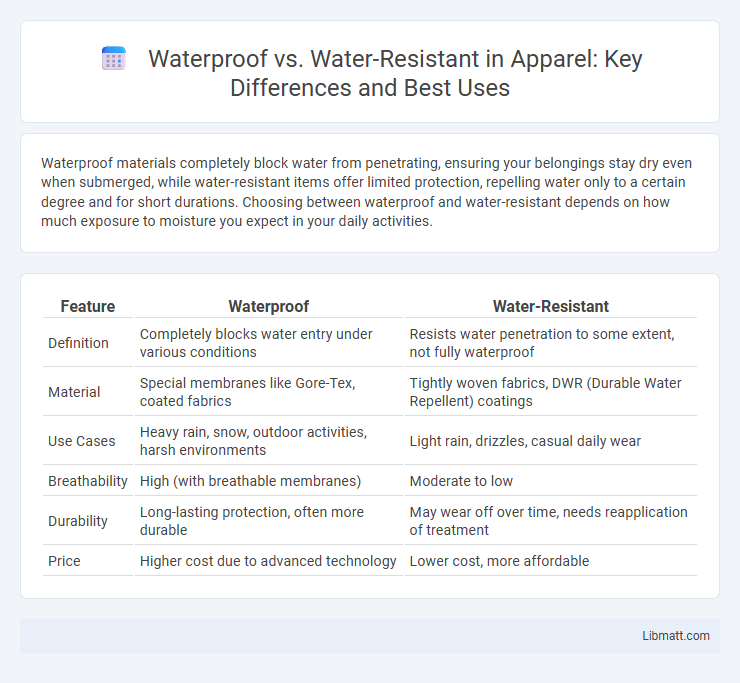Waterproof materials completely block water from penetrating, ensuring your belongings stay dry even when submerged, while water-resistant items offer limited protection, repelling water only to a certain degree and for short durations. Choosing between waterproof and water-resistant depends on how much exposure to moisture you expect in your daily activities.
Table of Comparison
| Feature | Waterproof | Water-Resistant |
|---|---|---|
| Definition | Completely blocks water entry under various conditions | Resists water penetration to some extent, not fully waterproof |
| Material | Special membranes like Gore-Tex, coated fabrics | Tightly woven fabrics, DWR (Durable Water Repellent) coatings |
| Use Cases | Heavy rain, snow, outdoor activities, harsh environments | Light rain, drizzles, casual daily wear |
| Breathability | High (with breathable membranes) | Moderate to low |
| Durability | Long-lasting protection, often more durable | May wear off over time, needs reapplication of treatment |
| Price | Higher cost due to advanced technology | Lower cost, more affordable |
Introduction to Waterproof vs Water-Resistant
Waterproof materials completely prevent water penetration, ensuring no moisture can pass through even under prolonged exposure, making them ideal for heavy rain or underwater use. Water-resistant products offer limited protection by repelling water to some extent, suitable for light rain or splashes but not full immersion. Understanding the difference between waterproof and water-resistant ratings, such as IPX levels or ATM pressure measurements, helps consumers choose appropriate gear for specific environmental conditions.
Defining Waterproof and Water-Resistant
Waterproof refers to materials or products designed to completely block water from penetrating, ensuring full protection even during prolonged exposure to moisture. Water-resistant items can resist water penetration to some degree but are not impervious, typically protecting only against light splashes or brief encounters with water. Understanding the distinction helps consumers choose appropriate gear for activities ranging from daily wear to extreme water sports.
How Materials Provide Protection
Waterproof materials create an impenetrable barrier by using tightly woven fabrics combined with coatings like polyurethane or rubber that prevent any water from passing through. Water-resistant materials rely on durable water repellent (DWR) finishes to repel light moisture but allow some water to seep in under heavy exposure. Understanding how your gear's materials provide protection helps you choose the right level of defense for your outdoor activities.
Industry Standards and Ratings
Industry standards for waterproof products typically follow the IP (Ingress Protection) rating system, where ratings like IP68 confirm full protection against water submersion beyond one meter. Water-resistant items often hold lower IP ratings such as IPX4, which indicates resistance to splashes but not full immersion. Understanding these ratings helps consumers differentiate between products designed for temporary exposure to water versus those built for prolonged underwater use.
Common Applications and Uses
Waterproof materials are essential for applications requiring complete protection from water, such as outdoor gear, diving equipment, and electronic devices used in aquatic environments. Water-resistant products, on the other hand, are suitable for everyday items like watches, jackets, and smartphones that need protection against minor splashes and light rain. Your choice depends on the level of exposure and durability you need to safeguard against water damage effectively.
Durability and Longevity Comparison
Waterproof materials provide superior durability and longevity by fully preventing water penetration, making them ideal for prolonged exposure to wet environments. Water-resistant items offer moderate protection by repelling light moisture but may degrade faster when frequently exposed to heavy water or submersion. Choosing waterproof products ensures extended lifespan and reliable performance in harsh or wet conditions compared to water-resistant alternatives.
Pros and Cons of Waterproof Products
Waterproof products offer complete protection against water, making them ideal for activities like swimming or heavy rain exposure, ensuring durability and reliability. However, they can be less breathable, leading to discomfort during prolonged use, and often come at a higher price point compared to water-resistant items. Your choice depends on the level of water exposure you anticipate and whether breathability or full protection is more important for your needs.
Pros and Cons of Water-Resistant Products
Water-resistant products offer a practical balance between protection and affordability, effectively safeguarding against light moisture and splashes, making them ideal for everyday use like casual watches or phone cases. However, they fall short in extreme conditions such as heavy rain or submersion, limiting their reliability for activities like swimming or diving. Your choice should consider the specific exposure risks, as water-resistant items require less maintenance but provide less security than fully waterproof alternatives.
Choosing the Right Option for Your Needs
Waterproof items provide complete protection against water penetration, making them ideal for activities like swimming, diving, or exposure to heavy rain. Water-resistant products offer limited protection, suitable for light splashes or brief exposure to moisture, commonly found in everyday wear or electronic devices designed for occasional wet conditions. Selecting the right option depends on the intensity and duration of water exposure expected in your specific use case.
Final Thoughts: Making an Informed Decision
Choosing between waterproof and water-resistant gear depends on your specific needs and the level of exposure to water you expect. Waterproof items offer complete protection against water ingress, ideal for heavy rain or submersion, while water-resistant products provide limited defense suitable for light rain or splashes. Understanding the difference ensures your investment protects your belongings effectively in your intended environment.
waterproof vs water-resistant Infographic

 libmatt.com
libmatt.com